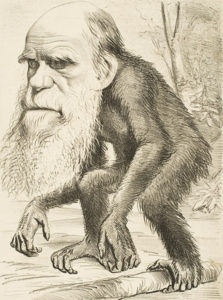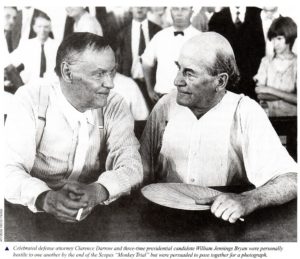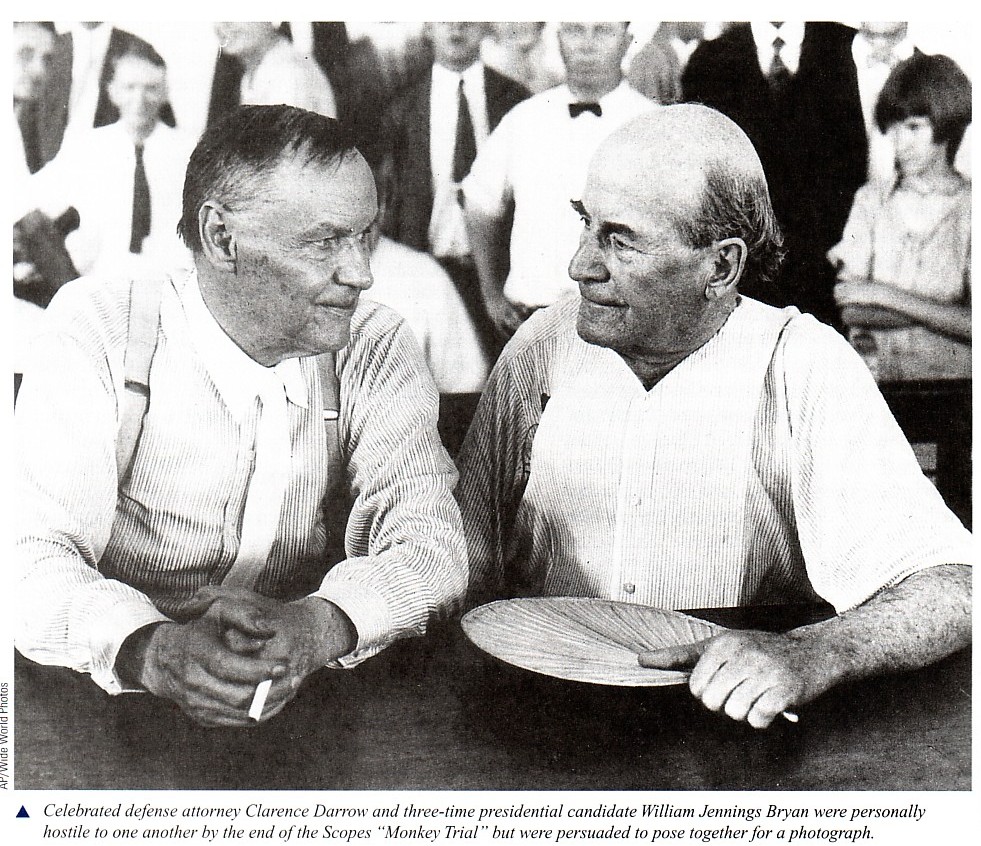
In the mid 1990s I had the opportunity to attend a local community play in the Rhea County Courthouse located in Dayton Tennessee. This courthouse was where one of the most famous trials of the twentieth century took place, the Scopes Trial. The New York Times described what took place there as “one of the most colorful and briefly riveting of the trials of the century that seemed to be especially abundant in the sensation-loving 1920s.” Every July local residents put on the play in the second floor courtroom, which has been restored to look the way it did during the July 1925 trial. In front of the courthouse is a plaque commemorating the place where John Scopes was convicted of violating a state law by teaching that humans descended from a lower order of animals.
In the basement of the courthouse is a museum, which contains memorabilia like the actual microphone used to broadcast the trial. When the annual play is put on, some of the museum pieces are used as props in the trial. The play’s dialogue is taken primarily from the transcript of the trial itself. The audience sits in chairs facing the judge’s bench. Members of the audience are selected to portray the jury, whose only task was to sit in the jury box and then leave the courtroom several times during the play when the real jury was excused.
Scopes was found guilty and he was fined $100, the minimum penalty. His attorney appealed the case to the Tennessee Supreme Court, which threw out his conviction on a technicality. He went on to study geology at the University of Chicago (on a scholarship by his supporters) and became a petroleum engineer. But almost 100 years later, his trial still represents one of the seminal times in American history where there was a clash between science and religion. Clarence Darrow, the famous defense lawyer who was one of the lawyers on the defense team for Scopes, said in his closing remarks:
I think this case will be remembered because it is the first case of this sort since we stopped trying people in America for witchcraft . . . We have done our best to turn the tide . . . of testing every fact in science by a religious doctrine.
That sentiment is still alive today, as is the perceived conflict between the scientific theory of evolution and the religious doctrine of creation. The public portrayal of the so-called evolution-creation “debate” has misconceptions similar to those evident in Darrow’s statement. One example of thie misconception is an article Rachael Gross wrote for Slate a couple of years ago, celebrating how “Evolution is Finally Winning Out Over Creationism.” A key factor in her analysis was pointing to how “a majority of young people endorse the scientific explanation of how humans evolved.” By scientific she means a purely secular evolution—something not directed by any divine power.
Her hope is there will be a continual shrinkage of those who oppose evolution. One way this would occur is through individuals “converting” to evolution, regardless of their political and religious beliefs. “For the movement behind evolution to triumph, younger Americans who have been raised to believe in creationism need to be open to changing their minds.” Another way is by “generational momentum,” meaning that the switch will happen as older adults who believe in creationism die off. This is not really simply a crass hope based on waiting for old people to die or that young people will switch their views with regard to the “doctrine” of evolution.
It also reflects the thought of science philosopher Thomas Kuhn in his book, The Structure of Scientific Revolutions. In this seminal work on the history and philosophy of science, Kuhn said that normal science referred to research firmly based on one or more past scientific achievements that a particular scientific community “acknowledges for a time as supplying the foundation for its further practice.” The process of normal science takes place within a scientific paradigm—where research occurs within the context of a scientific community committed to the same rules and standards for scientific practice. “That commitment and the apparent consensus it produces are prerequisites for normal science.” Kuhn acknowledged that the notion of his term ‘paradigm’ is intrinsically circular: “A paradigm is what the members of a scientific community share, and, conversely, a scientific community consists of men [and women] who share a paradigm.”
Any new interpretation of nature, whether a discovery or a theory, emerges first in the mind of one or a few individuals. It is they who first learn to see science and the world differently, and their ability to make the transition is facilitated by two circumstances that are not common to most other members of their profession. Invariably, their attention has been intensely concentrated upon the crisis-provoking problems; usually, in addition, they are men [or women] so young or so new to the crisis-ridden field that practice has committed them less deeply than most of their contemporaries to the world view and rules determined by the old paradigm. How are they able, what must they do, to convert the entire profession or the relevant professional subgroup to their way of seeing science and the world? What causes the group to abandon one tradition of normal research in favor of another?
In answering these questions, Kuhn went on to observe that the proponents of competing paradigm are always at least slightly at cross-purposes. “Neither side will grant all the non-empirical assumptions that the other needs in order to make its case.” While each may hope to “convert” the other to his or her way of seeing science and its problems, the dispute is not one “that can be resolved by proofs.” Kuhn quoted the theoretical physicist Max Planck who said: “A new scientific truth does not triumph by convincing its opponents and making them see the light, but rather because its opponents eventually die, and a new generation grows up that is familiar with it.” Kuhn went on to say:
The transfer of allegiance from paradigm to paradigm is more like a conversion experience that cannot be forced. Lifelong resistance, particularly from those whose productive careers have committed them to an older tradition of normal science, is not a violation of scientific standards but an index to the nature of scientific research itself.
Darwin’s theory now exists as a foundational paradigm for a secular understanding of human origins. Within this context, Rachael Gross hopes for a completed paradigm shift within evolution that denies the possibility of any intervention from outside of the natural order. Young adult believers in creation need to convert fully to a belief in secular evolution. There is no room in her sense of evolution for theistic evolution/evolutionary creation. At most, it exists as a way station on the journey to secular evolution.
From this perspective, evolutionary creation unscientifically combines religious belief and evolution. Its needs to be jettisoned within a sincere scientific conversion experience to evolutionary belief. Older adults who are committed to the unscientific tradition of creation need to die off. Gross is carrying the banner once waved by Clarence Darrow in the Scopes Trial: “We have done our best to turn the tide . . . of testing every fact in science by a religious doctrine.” The evolutionary revolution marches on.

However, there is an unacknowledged assumption with regard to the philosophy of science when Gross equates secular evolution with “science.” Basic philosophical assumptions necessary for science include that nature is uniform; and that observable patterns in nature provide clues to help us understand the unobservable patterns and processes in nature. Our knowledge of the processes and patterns in nature is limited since we have not yet examined all there is to see in nature, nor have we observed it throughout it entire existence. This uniformity in nature is then necessarily assumed to hold universally. We assume the uniformity of natural causes in creation, in nature, but cannot prove it is true scientifically.
Francis Schaeffer pointed out that while early scientists like Francis Bacon and Isaac Newton believed in the uniformity of natural causes, they did not believe this natural uniformity existed in a closed system. He said this little phrase constituted the difference between natural science and a science rooted in naturalistic philosophy. It was the difference between what he called modern science and modern, modern science. In Escape from Reason, Schaeffer said: “It is important to notice that this is not a failing of science as science; rather the uniformity of natural causes in a closed system has become the dominant philosophy among scientists.”
Secular evolution would then be the product of what Schaeffer called modern, modern science. It rejects the possibility of a god or transcendent power outside of nature utilizing the natural process of evolution to develop life on earth. From this perspective, the Scopes Trial was fundamentally a dispute over two different systems of scientific philosophy with regard to evolution. The ridicule of literalist biblical belief and interpretation, embodied in the exchange between Darrow and Bryan, was collateral damage in the exchange. The underlying structure of the dispute over evolution is over the philosophical basis on which science can be done.
Pitting religion and science against one another as Darrow, Bryan and others have done, not only sets up a false dichotomy between them, it gives a distorted view of what the evolution revolution is all about.
If you are interested in learning more about the Scopes Trial, try this page about the Scopes Trial Museum or the Wikipedia page on the Scopes Trial. You can also read: Summer for the Gods, a Pulitzer Prize winning book about the Scopes Trial and “No Contest; No Victory.” Also, read: When All the Gods Trembled, which discusses Darwinism and the Scopes Trial.





